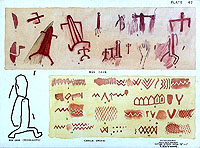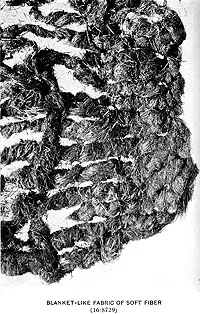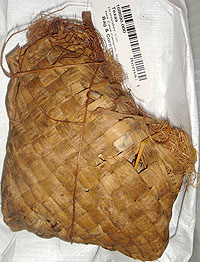Bee Cave Canyon
The Bee Cave Canyon site (41BS8) is located where Upper Rotten Draw drains into Chalk Draw in the Santiago Mountains of south-central Brewster County. At 230 meters (770 feet) long and 33 meters (110 feet) wide, it is the largest known rockshelter in the Big Bend region. While the site is often referred to merely as �Bee Cave,� there is another shelter by the same name in the Lower Pecos, hence the Brewster County site is formally known to archeologists as the Bee Cave Canyon site.
Bee Cave Canyon has a nearby source of permanent water: a tinaja (natural reservoir) formed by water falling over 100 feet from the canyon rim. It is completely sheltered from the rain, protected from the cold winter winds while open to summer breezes, and offers a view for miles to the east and southeast. The prehistoric peoples of the Big Bend took advantage of such a favorable locale and occupied the site repeatedly, leaving behind a rich record of their activities--deposits of occupational debris reaching at least seven feet in depth.
Bee Cave Canyon was the subject of the earliest large-scale scientific excavation conducted in the Big Bend. It was �discovered� in February of 1928 by M. R. Harrington of the Museum of the American Indian, Heye Foundation, of New York. He began excavating the site shortly thereafter, but left the Museum before he finished. Edwin F. Coffin, also of the Museum, picked up where Harrington left off and worked in partnership with the Cambridge University Museum, Cambridge, United Kingdom. Coffin began in February of 1929 and worked at the site until June. He published the results of the excavation in 1932. Though Coffin did not describe his excavation techniques, he most likely followed the standard procedure of the time, which was to record the depths of major artifacts and features from the ground surface, without horizontal provenience. Most archeologists in those days dug to find artifacts suitable for museum display and uncover major features, especially architecture.
The most unusual feature of Bee Cave Canyon is its �house� structures. The remains of six houses�that might better be termed �rooms� or �walled enclosures��were documented in close proximity to one another at the east end of the shelter. These structures, of which the recognizable remains of several still exist, are sub-rectangular in shape formed by low U-shaped stacked-stone walls abutting the back wall of the shelter. In some cases the stacked stones were filled in with a mixture of adobe and ash and the lower walls of one structure was said to be plastered. They had substantial floors made of grass, but no evidence of roof supports, at least according to Coffin. However, in House 5, Harrington reported finding evidence of a center roof support, rafters, and buried roof poles about two inches in diameter running parallel to the bluff wall. He stated that the upper walls had collapsed, obscuring construction details.
Remnants of seven additional stone enclosures were found toward the center of the rockshelter on higher, more steeply sloping ground. Four of them were not intact, but at least three of them were intact and about the same size as the six �houses,� while one other was only slightly smaller. It is likely that these represent the same type of structure as the "houses," making a total of at least 10 walled enclosures. A single structure was said to have had a small shallow fire pit or hearth near its center and the grass floor fringing the pit was said to be scorched.
All of the intact enclosures have low stone walls no higher than two feet above the ground surface, but with no gaps for doors. House 3 had habitation levels extending at least 24 inches below the surface. While some of the smaller enclosures may represent storage facilities, the interior space of all but one of the intact enclosures measures 3-4 meters (10-13 feet) in maximum dimension. The consistent size of the walled enclosures combined with the evidence of prepared grass flooring and the presence of at least one internal hearth suggests that these may well have been sleeping rooms for individuals or nuclear families. Below the occupation layer of some of the enclosures was an earlier layer that contains beds made of grass on frameworks of branches that are tied together.
Two large burned rock features measuring 10-15 feet in diameter were identified toward the front of the cave between the two areas with enclosures. The larger of the two did not contain any artifacts, but the smaller was surrounded by pieces of roasted sotol crowns, leaves that had been stripped from them, quids (chewed fiber chunks), plant seeds, corn cobs, and other food refuse. This strongly suggests that these features represent roasting pits within which earth ovens were built to bake sotol—a process which is known to require 24-48 hours.
Bee Cave Canyon is also known for the rock art that is widely scattered along its immense back wall. Coffin, A.T. Jackson, and Forrest Kirkland all studied the shelter�s rock art in the 1930s. But many painted elements remained undocumented until recently. The art consists mainly of pictographs that are painted in various hues of red ochre ranging from purple red to orange and line drawings made by soft red and yellow ochre pebbles and charcoal.
Most of the painted images appear as anthropomorphs (human-like figures) and carefully arranged designs with smooth edges that were likely applied by a hair brush. The line drawings were more hap-hazard and appeared to be quickly applied to the rock surface without much thought to design or careful application. There are also stamped hand prints in orange pigment and an outline of a hand and forearm traced in red ochre. In addition to the pictographs there are also petroglyphs, art that is scratched or pecked into the rock surface. One large pecked petroglyph is stylistically similar to a nearby large anthropomorphic pictograph. Both appear to be side views of running or walking anthropomorphs. Most of the petroglyphs are scratches superimposed over the pictographs in a manner that appears to be an effort to remove the pictograph or at least place it in a secondary position, as if the later inhabitants of the shelter sought to obliterate or lessen the presence or power of the former inhabitants.
In addition to rock art, a variety of decorated artifacts have been found at Bee Cave Canyon. The most remarkable of these are 24 small human figurines made of untempered and unfired clay. The figurines consist of only a head and torso and are decorated in black, red, and yellow designs. Many depict breasts and buttocks, suggesting that they may have been fertility charms. Two bone fragments decorated with scored parallel lines were also recovered from the site. One has a series of painted black dots running lengthwise and the other is smeared with red paint and striped with black paint. Other decorated artifacts include a number of river pebbles and pieces of flaked stone decorated with red and black painted designs, two fragments of metates painted red on one side and black on the other, and a small, flat piece of wood that depicts a dragonfly, a butterfly, and a rectangular object painted in black.
Bee Cave Canyon has yielded an incredible number of artifacts from cultural deposits that were over 1 meter (3 feet) deep in some places. Most of the site�s stone artifacts are fairly typical of rockshelters in the region, such as flakes, grinding stones, hammerstones, arrow points, dart points, scrapers, saws, knives, tubular smoking pipes, boiling stones, a stone bowl, and the fragment of an axe. More unusual are two rough stones attached to a fiber cord and four unworked stones wrapped with grass and cactus spines that have a vegetable substance protruding from under the wrappings. Also found were artifacts made of antler, such as apparent pestles, a flaking tool, and a skin scraper.
Bee Cave Canyon�s most spectacular artifacts are its perishable ones, most of which are made from wood and yucca leaves. The wooden artifacts include stakes, digging sticks, paint sticks, fragments of rabbit sticks, fire tongs, fragments of fire drills and fire-starting boards, parts of a snare, a notched rhythm stick, possible gaming implements, atlatl fragments, two small bowed sticks ("toy bows"), and arrow foreshafts, two of which were found with fragments of arrow points held in place by sinew wrapping.One of the site's unusual wooden artifacts is a stick of wood that is charred at one end and has two strips of leather attached with sinew to the other. Coffin has speculated that this was used to process corn.
The people of Bee Cave Canyon used yucca leaves to make a variety of objects. Net bags, matting, sifting baskets, coiled basketry, sandals, knots, string, a woven pouch that contained corn and squash seeds, and even a baby carrier were all made from yucca. A cylindrical basket that contained a piece of hematite, five small pieces of sinew, and a quantity of fine yucca fiber may have been part of a fire-making kit.
Yucca cord was also used to string jewelry. Three unstringed pendants of stone and shell were recovered from the site, as well as a shell pendant, two short strands of beads made from seeds, and a short strand of beads made from cut sections of reed. The site�s few fiber artifacts not made of yucca leaves were made of sotol leaves. These include a bag and a woven object that resembles a hammock.
Despite the fact that Bee Cave Canyon was excavated at a time when floral recovery techniques were not very sophisticated, a surprising array of plant remains was recovered from the site. The people of Bee Cave Canyon consumed prickly pear, mesquite beans, acorns, Mexican walnuts, soap berries, pi�on nuts, sotol, desert willow pods, and the seeds and pods of yucca. The seeds of corn, squash, and amaranth were also recovered from the site, suggesting that the people of Bee Cave Canyon practiced agriculture, although it is not clear whether they did this in the vicinity of the rockshelter or elsewhere.
Pieces of skin twisted on strings, fragments of leather, and twisted strips of skin were likely used by the people of Bee Cave Canyon to make skin blankets or clothing. A more unusual blanket was made of fine fiber and strings and was found folded on top of a checker-weave mat that had been placed on a piece of leather about the same size. Other perishable artifacts recovered from the site include gourd vessels with wooden stoppers, reed pipes, reed arrowshafts, some with wrappings and shreds of feathers, and tubular reed containers stopped with grass plugs that contained amarynth seeds.
The remains of a flexed human skeleton minus the skull was found in the central area of the shelter between the large fallen boulders and the back wall of the bluff during the 1928 excavation carried out by Harrington. Artifacts found in association with the burial “included a bowl shaped coiled basket, part of a twined open work cigar shaped basket, fragments of a bag made of fiber cord, many small beads made of cane, and part of a necklace made of the legs of a large iridescent green beetle neatly strung on a fiber cord. Among the vertebrae was a wicked looking flint spearhead, and near the pelvis lay a deposit consisting of three red paint-stones and two flint knives”. During the 1929 excavation conducted by Coffin, three left halves of lower human jaws were recovered approximately thirty feet from the trench where the skeletal remains were discovered by Harrington, and one left half of a jaw was found in House 6. This may be an odd coincidence, or it may be the result of the burial practices of the site’s residents. There were no artifacts reported in association with the jaw bones.
No radiocarbon dates have yet been obtained from Bee Cave Canyon. While its projectile points have not been typed, they include dart points dating to the Middle and Late Archaic periods. Also present were arrow points, wooden bows, and at least one potsherd dating to the Late Prehistoric period. The seeds of domesticated plants probably also date to the Late Prehistoric era. The presence of at least two occupation layers attests to multiple occupations, but the intensity and duration of these various occupations is unclear. Clearly, Bee Cave Canyon was a major occupation site used repeatedly over a span of at least three to four thousand years.
Bee Cave Canyon is a truly remarkable site that reveals an astonishing amount of detail about the lives of the people who called it home. Sadly, portions of it were destroyed by vandals soon after Coffin�s excavation. While some of the pictographs recorded by Coffin, Jackson, and Kirkland have since deteriorated, researchers from the Center for Big Bend Studies (CBBS) have recently carried out additional research. Using digital photography and image enhancement techniques, these researchers have been able to document a number of other rock art panels that had previously been overlooked or ignored. The CBBS researchers also believe that some portions of the rockshelter may still contain intact deposits. This site is worthy of new field investigations and modern scientific analysis of the artifacts recovered during the original field work. These are housed in the National Museum of the American Indian, which is now part of the Smithsonian Institution, as well as the Cambridge University Museum.
Contributed by Carly Whelan with help from Reeda Peel.
Sources
Coffin, Edwin F.
1932 Archaeological Exploration of a Rock Shelter in Brewster County, Texas. Monograph No. 48, Museum of the American Indian, Heye Foundation, New York.
Jackson, A.T.
1938 Picture-Writing of Texas Indians. Anthropological Papers, Vol. II, Bureau of Research in the Social Sciences, Study No. 27, The University of Texas Publications No. 3809, Austin.
Kirkland, Forrest and W.W. Newcomb, Jr.
1967 The Rock Art of Texas Indians. University of Texas Press, Austin and London.
Mallouf, Robert J.
1985 A Synthesis of Eastern Trans-Pecos Prehistory. Unpublished Master�s thesis, Department of Anthropology, University of Texas, Austin.
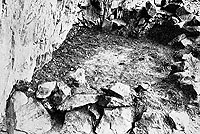
|
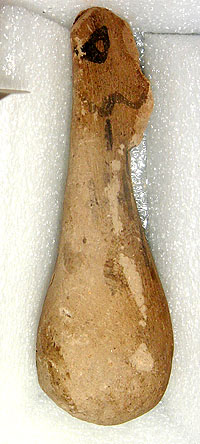
|
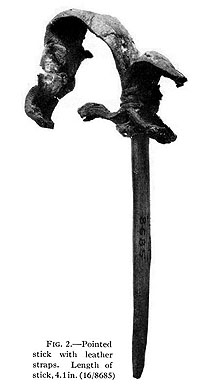
|
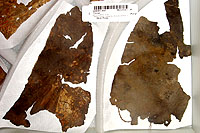
|
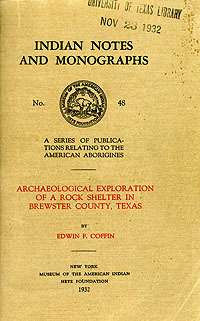
|
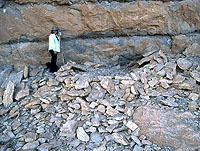
|
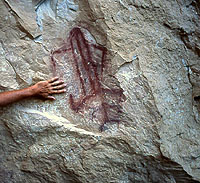
|
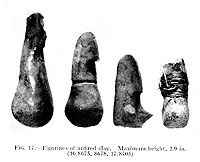
|
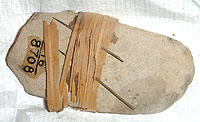
|
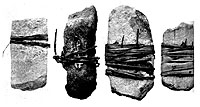
|

|

